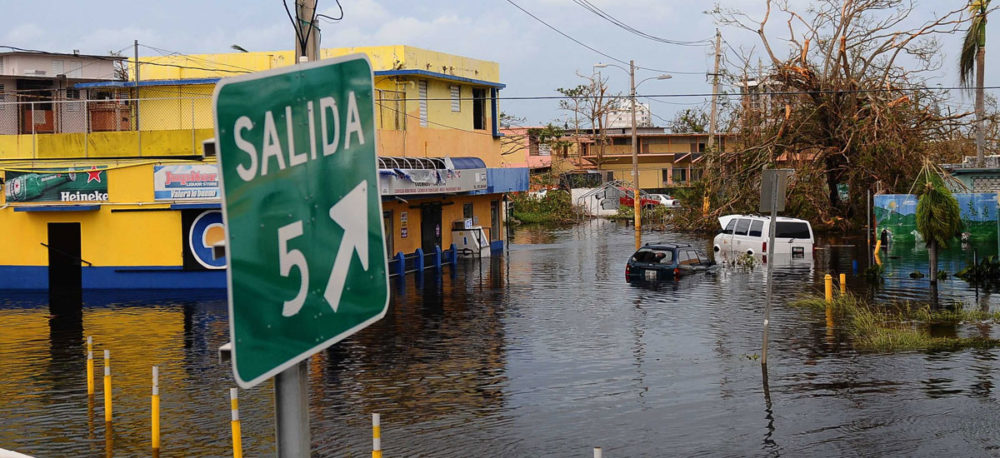The recent hurricanes have spotlighted the federal government’s crucial role in response and recovery. But much of the coverage has focused on FEMA, funding, and the US military. Rarely in the news—and yet critical to response and recovery efforts—is the work of the Environmental Protection Agency.
During the Trump administration, the EPA has seen cutbacks in staff, major funding reduction proposals, and a real change in culture. And while much of the public discussion about the EPA has focused on its regulatory role, there is far more to the agency than just regulation—and all of its functions are being affected by recent changes.
To understand why we need a strong and capable EPA to respond to disaster like Hurricane Maria (and Irma and Harvey) I spoke with two former leaders of EPA, Thomas Burke and Stan Meiburg. Dr. Burke served as the EPA Science Advisor and Assistant Administrator for Research and Development until the end of the Obama Administration. Now on the faculty of Johns Hopkins, he is widely recognized for his work in public health and risk assessment.
As he emphasized, “EPA has a very important role because Maria is, unfortunately, first and foremost an environmental disaster… the biggest challenge is that there is a fundamental change in risks to the populations in island communities and coastal areas.”
Before the storm
Stan Meiburg served as the Deputy Administrator of the EPA from 2014-2017. In his 39 years with the agency he worked in both regional offices and headquarters. He is now on the faculty of Wake Forest University directing their sustainability program.
Dr. Meiburg explained that the EPA’s role begins before a storm like Maria hits. Hurricane forecasting, by NOAA’s National Hurricane Center, has come a long way over the last few decades, so EPA officials watch closely as a hurricane intensifies. At the EPA, the job of preparing for the storm means activating the incident command center at the EPA Regional Office (Region 2 in New York for Puerto Rico and the USVI), Dr. Meiburg explained. The regional office of EPA includes about 40 permanent staff in Puerto Rico itself and has experience with the communities at risk from the oncoming storm. To the extent possible, the agency also pre-deploys mobile labs and other equipment—a task that naturally presented a special challenge for the islands.
As the regional office begins this work, Dr. Burke noted that the EPA also must mobilize on a broader scale. “EPA should be at the table for the national effort coordinated at the highest level with the National Security Council with FEMA, Department of Defense, Health and Human Services, and Center for Disease Control. It’s a team approach,” he said, adding that “the military is great because they have the capabilities to do the heavy lifting, but they constantly need scientific guidance. They constantly need analytical capability and risk assessment. That’s the role for the EPA at all levels.”
Recovery
After Hurricane Maria passed, its devastation became apparent as island officials described the enormity of the humanitarian crisis. Dr. Burke explained that, for the EPA, the focus must be “all about exposure and getting back the necessities of life.” As he put it, “you need the folks who know the water systems—who can be out there to assess water quality, damage to infrastructure for waste water treatment or the drinking water system to make sure people aren’t exposed to waterborne diseases and contaminants. That’s EPA.”
Dr. Meiburg agreed. He stressed that electricity is the dominant concern because, without that, it is difficult to deal with anything else. He noted that the decision to put the Army Corps of Engineers in charge of rebuilding the electric grid makes a lot of sense. But the next urgent need is to rebuild the infrastructure needed for clean water and sewers, as well as waste disposal (including for the debris from the storm). In that effort, he says, the EPA has a critical role to play. Dr. Burke pointed out that with water, sewer, and disposal systems down, the risks from both waterborne and vector-borne (e.g., mosquitoes, rats) disease can very quickly rise. And the EPA is the agency with expertise with pesticides and other control methods.
Dr. Meiburg also pointed out several other high-priority efforts for the recovery that EPA must staff. The integrity of Superfund hazardous waste sites must be checked as soon as possible, he said. Industrial facilities need attention for leaks, spills, and in their restart operations. And hazardous waste from both commercial and household sources are a difficult and dangerous problem in wake of the storm. All of these require staff and other resources. And the problems are urgent.
The long road
Given the scale of the disaster in Puerto Rico and the USVI, indeed throughout much of the Greater Antilles, the recovery road is a long one—even with a massive effort. Both Drs. Burke and Meiburg emphasized the need for EPA to have a sustained presence on the islands, as well as in the other areas impacted by hurricanes over the last month or so. That means that the agency will have extraordinary responsibilities that will require the staff and resources to provide the help that’s urgently needed.
Rebuilding critical infrastructure means constant attention from scientists and engineers in the agency. It also means deep and sustained coordination with the Commonwealth’s government as well as in the USVI. As Dr. Burke noted, “it is all about human health.” That means the EPA regional office, the EPA national laboratories and headquarters staff must take on huge additional responsibilities.
The Environmental Protection Agency is a crucial national asset, every bit as important as the military in responding to humanitarian crises. Its staff needs our appreciation, but more than that, they need adequate resources and support to effectively do their vital work.

